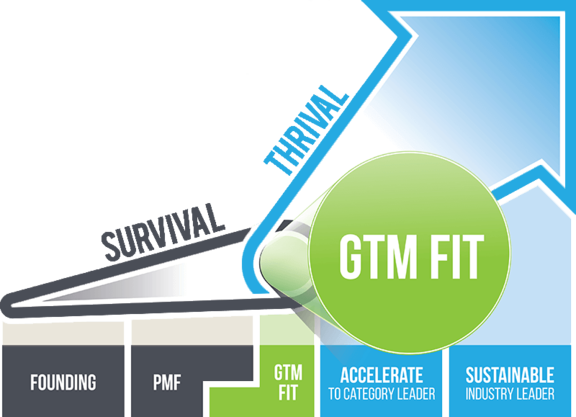The Missing Link for Growth
When many enterprise startups get to Product-Market-Fit, they feel they’re ready to take off. “We have product-market fit! Let’s grow! Hire sales! Invest in marketing! Spend!”
The unfortunate frequent reality kicks in. Instead of sales taking off, sales just bump along. The number of new customers grows sporadically, painfully disproportionate to the rapid increase in sales and marketing.
Many enterprise startups get to PMF but don’t achieve growth and acceleration.
Why? Because there’s a “missing link” between PMF and accelerated growth for the enterprise startup journey.
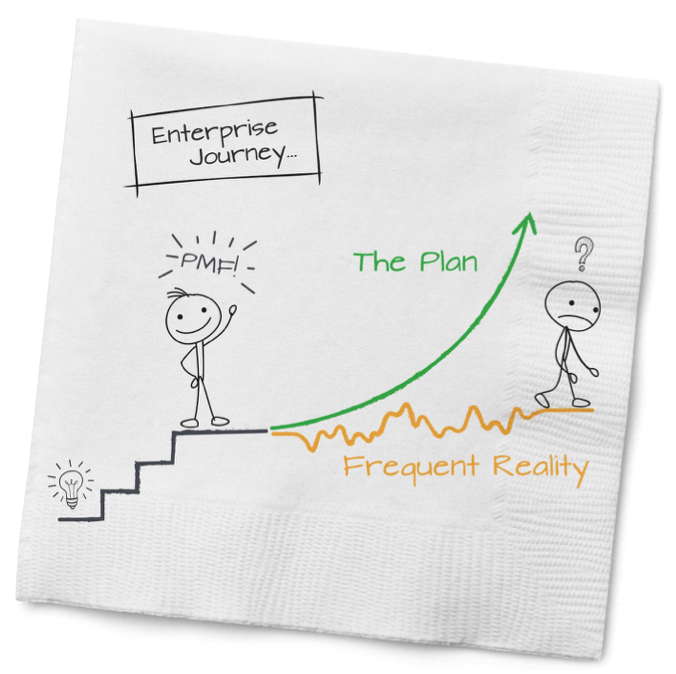
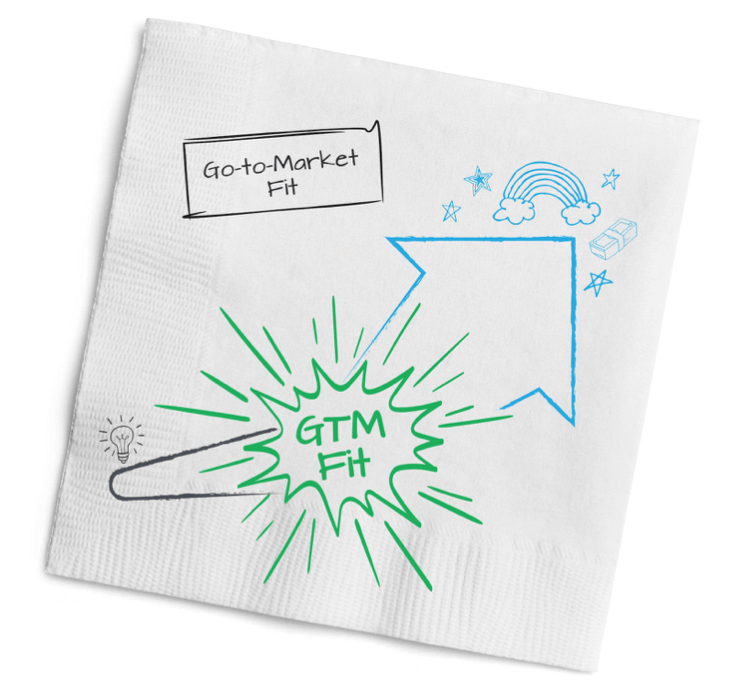
The missing link is something we call Go-To-Market Fit, or GTM Fit. We think it’s every bit as important for enterprise startups as Product-Market-Fit.
We introduced this concept of Go-To-Market Fit in our first book, Survival to Thrival: Building the Enterprise Startup.
Finding GTM Fit: The 4-Step Path
The response to the book was incredible, and notes from readers showed us we had many questions left to answer. Many responded: “We appreciate the insight of Go-To-Market Fit… but how do we find it?” So, we decided to mine the experiences of our portfolio companies to find a “recipe” for achieving GTM Fit. Now, we’re releasing our repeatable, 4-step path to finding GTM Fit:
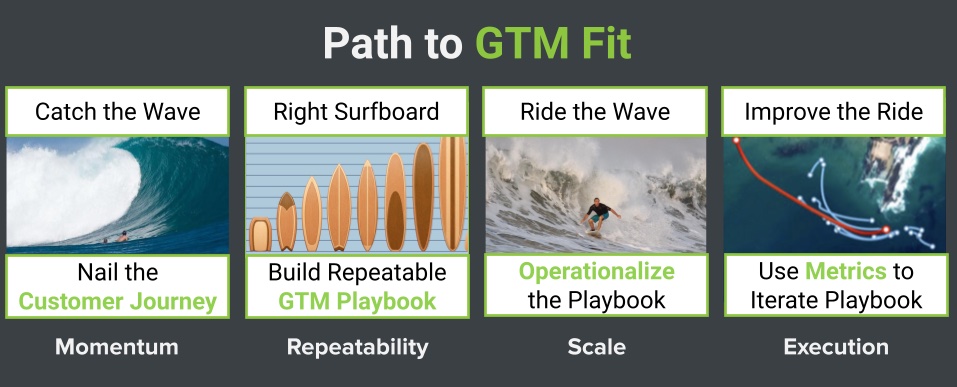
Finding Go-To-Market Fit is a challenge that has four steps:
- Nail the Customer Journey — and you harness lots of momentum.
- Create a Repeatable GTM Playbook — and you get repeatability.
- Operationalize the Playbook — and you can scale the GTM.
- Iterate with Metrics — and you can improve GTM execution.
We decided to open-source our Go-to-Market Fit recipe by creating a new GTM Fit Guide: UNLOCK. UNLOCK is based on Chapter 3 (Go-To-Market Fit) from our first book, which we’ve updated in an amplified, online format. It goes in-depth on each of the 4 steps and includes 100+ pages of new content, real-life examples, and downloadable resources to help you find GTM Fit. UNLOCK is now available in beta mode at unlock.survivaltothrival.com.
#1 Nail the Customer Journey
The Customer Journey (CJ) is the backbone of your entire Go-To-Market. Everything else is built on top of it. The CJ starts with the Urgent Pain and ends when your company becomes strategic to the customer. This is especially critical for SaaS startups, since signing the contract is only the beginning of the relationship with the customer, and so much of the business is based on renewals and upsells.
To understand the customer’s perspective on the CJ, we interviewed Cybersecurity & Technology Exec JJ Juergensen, who illuminated the fundamental difference between the customer and the founder: risk asymmetry. What does your customer stand to gain if your product works, and what does he or she stand to lose if it doesn’t? While founding CEOs are usually focused on the former, customers are focused on the latter. By breaking this asymmetry, you can become strategic to the customer and unlock scalable growth.
You can learn more about how to break risk asymmetry in UNLOCK here.
#2 Build the Go-to-Market Playbook
Once you’ve found the urgent pain for your ICP and understand the customer journey, how do you repeatedly find and win ICP’s that have the urgent pain? This is where the Go-To-Market Playbook comes in.
The GTM playbook is a step-by-step, repeatable recipe to find and win deals over and over again. It becomes the blueprint for your marketing and sales teams. It becomes the bible for every new sales or marketing person to ramp. It becomes a powerful tool to align the rest of the team behind a go-to-market plan. The GTM playbook is the backbone for repeatable sales that is the core of GTM Fit and unlocking growth. It’s that important.
UNLOCK is full of real-life examples and advice on how you can find the “Wows” that speed up deals and identify deliverables for every stage of the playbook.
#3 Operationalize the Playbook
Unfortunately, the Go-to-Market Playbook doesn’t execute by itself. The GTM playbook needs an owner: the CEO.
Why the CEO? The GTM Playbook cuts across marketing, sales, product, and customer success. It’s the most cross-functional project there is in a startup! The CEO is the only person with the visibility to see across the company — and the authority to get the whole company behind it.
Moving through the stages of the GTM Playbook is like a relay race — passing the baton from one leader/team to the next. Identify which department or function takes the baton for each stage of the playbook. Like a relay race, the handoffs are where races are won or lost: the baton is either smoothly handed to the next stage, or it’s fumbled. In UNLOCK, we explain how to identify handoffs and troubleshoot handoff problems when they come up.
#4 Iterate with Metrics
Here’s how you’ll know you’ve achieved Go-To-Market Fit. You’ll just feel it. It feels like pure momentum — like you are surfing a wave.
You can also see it in the numbers. The two key metrics are Net New ARR (which measures the growth) and the Magic Number (which measures the efficiency of the growth). In UNLOCK, we break down what drives those two metrics.
Have you found Go-to-Market Fit?
Here’s how you’ll know you’ve achieved Go-To-Market Fit. You’ll see it in the numbers. And you’ll just feel it. It feels like pure momentum.
In UNLOCK, we break down the key metrics to know you’ve found GTM Fit: Net New ARR and the Magic Number.
Ready to learn more?
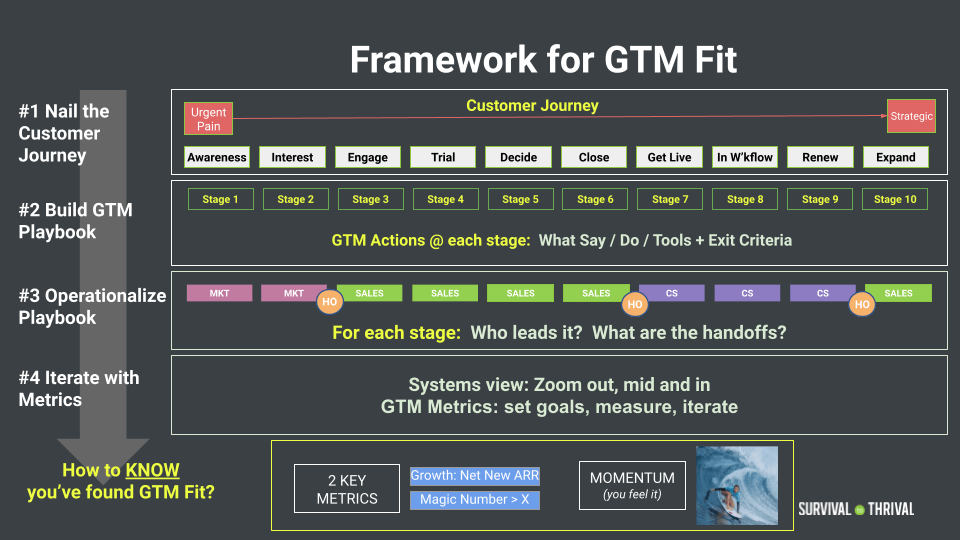
UNLOCK is now available in beta mode. It includes 100+ pages of new content, real-life examples, and downloadable resources to help you find GTM Fit. Check it out and send us your feedback on the Unlock page or at S2T@stormventures.com.
Read UnlockAbout

Bob Tinker
MobileIron Founder/CEO
Punchline Guy

Tae Hea Nahm
Storm Ventures VC/Board Member
Model Guy
